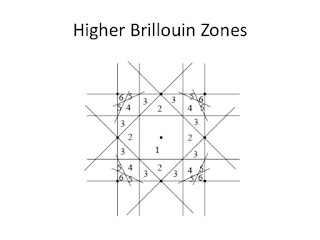This week in my Solid State Physics class I taught covered weak periodic potentials (including higher Brilloiun zones and Fermi surface reconstruction) and the tight binding model. I closely follow chapters 9 and 10 in Aschroft and Mermin, which was published in 1975.
This topic is somewhat iconic in that it features on the front and back cover of the book.
I think for the first time I understood the higher Brilloiun zones (rather than being overwhelmed by the geometrical complexity) and how this leads to the complex hole Fermi surfaces for metals of valence 2, 3, and 4. The key to visualising this better is just to do the problem in two dimensions first.
This got me wondering: why do we teach this stuff to students?
First, there is the intellectual beauty of the subject: how simple analytical and geometrical models can capture the complex band structures and Fermi surfaces of elemental metals.
However, today almost no one cares about elemental metals, or at least does research on them.
Note that most physics undergraduates and graduates don't ever take a course on nuclear physics. My department does not even teach one! Yet, the subject is a beautiful one and of great historical importance (both intellectually and politically!). The reason for this is that there is now very little research in basic nuclear physics. (I think this is a bad thing, but that is another story..)
But, metal physics is different.
A compelling reason I teach it in detail is that it provides a foundation to understand so much condensed matter research today: particularly how strongly correlated electron materials do (and do not) deviate from the Fermi liquid paradigm. Otherwise, I think Ashcroft and Mermin type courses would have been eventually sent off to the electrical engineering and materials engineering departments.
One can argue that almost happened. For the decade (1975-1985) following publication of the book, the content (not just on metals but also superconductivity) must have been largely of historical interest or considered only of interest to those working in "applied physics". But, the discovery of superconducting cuprates, heavy fermions, organic charge transfer salts, and iron pnictides, changed all that....
Subscribe to:
Post Comments (Atom)
What does learning to ride a bicycle teach us?
How do you learn to ride a bicycle? How do you teach someone to ride a bicycle? It is not easy to put this into words and that is an importa...

-
This week Nobel Prizes will be announced. I have not done predictions since 2020 . This is a fun exercise. It is also good to reflect on w...
-
Is it something to do with breakdown of the Born-Oppenheimer approximation? In molecular spectroscopy you occasionally hear this term thro...
-
Nitrogen fluoride (NF) seems like a very simple molecule and you would think it would very well understood, particularly as it is small enou...






Not to mention the "band-structure revolution" of the past decade -- graphene, TI's, Weyl semimetals and all that...
ReplyDelete